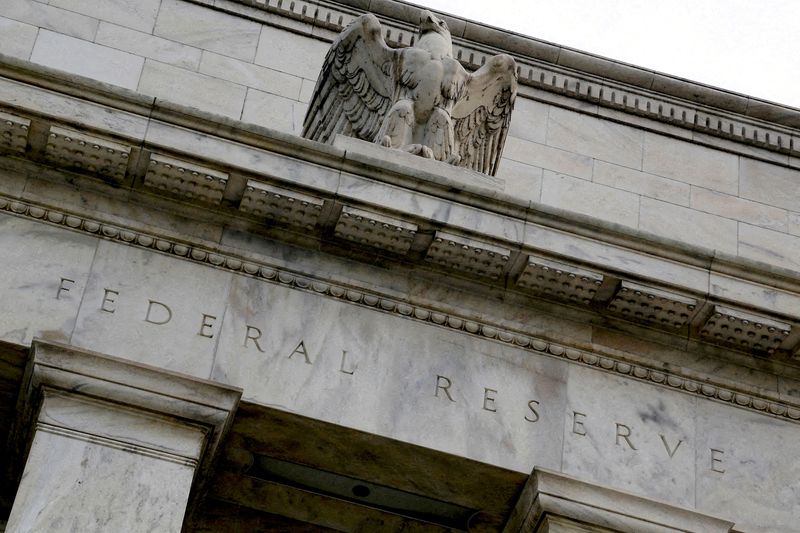By Jamie McGeever
ORLANDO, Florida (Reuters) -Markets are struggling to disentangle their assumption the Federal Reserve will quickly reverse its final rate rise within months from anxiety around a summer debt ceiling showdown - and suspect rates pricing may be skewed by the latter.
Policymakers have indicated, via their median 'dot plot' projections and public comments, that rates will likely stay high until the end of the year, yet futures markets are still betting they will be cut.
One reason for the disconnect is the fear stress around the debt standoff will damage the economy and markets enough to force the Fed's hand.
Unless congressional agreement is reached, Treasury will run out of cash some time around June-October, roughly when or just after rates are expected to reach the peak of the most aggressive hiking cycle in 40 years.
Congressional brinkmanship over sovereign default is all too common. According to the Treasury, Congress has acted 78 times to permanently raise, temporarily extend, or revise the definition of the debt limit since 1960.
What is rare is having that uncertainty coincide with the Federal Reserve cranking up interest rates. The current situation could not be further removed from the last time debt ceiling episodes really spooked markets in 2011 and 2013.
"Fed pricing wasn't an issue then. This time around it is the culmination of factors that is making the market so nervous," said Gennadiy Goldberg, U.S. rates strategist at TD Securities. "There's no hiding place."
When the U.S. government came within hours of running out of cash in mid-2011 and October 2013 U.S. interest rates were anchored at a record low 0%-0.25% range that would ultimately hold for seven years between late 2008 and late 2015.
The path for interest rates was not a concern. The Fed's message was clear - cementing the post-GFC recovery and vanquishing the forces of deflation would keep official borrowing costs anchored around zero for a long time.
It's a very different story today.
THE X-DATE FACTOR
Historical comparisons are hard. One possible way is comparing the spread between T-bill yields and overnight index swaps (OIS), effectively implied Fed expectations, in the run-up to previous crisis points.
The three-month bill yield is currently around 15 basis points higher than three-month OIS. Last week the spread was as wide as 30 bps.
This is uncommon - all else equal, bills should yield less than OIS. Even in 2011, when the U.S. sovereign credit rating was downgraded for the first time, bills still yielded less than OIS, while the distortions in 2013 flipped the spread by only a few basis points.
So it seems investors are not only reluctant to hold T-bills maturing over the next three-six months because that's when the government may run out of cash - the so-called 'X-date' - but also because of the murky outlook for monetary policy.
The Fed is expected to raise rates again in May and could still even tighten again in June if policymakers think inflation and growth data warrant it.
This is partly behind the elevated level of bill yields for the coming months, but going further into the third quarter they start to fall back again sharply.
"Some people may be building some debt ceiling risks into their monetary policy expectations," said Benson Durham, head of global policy at Piper Sandler. "The debt ceiling and monetary policy are going to be more intertwined in the coming months."
The debt ceiling is the maximum amount the U.S. government can borrow to meet its financial obligations. When the ceiling is reached, the Treasury cannot issue any more bills, bonds or notes. It can only pay bills through tax revenues.
U.S. House of Representatives Speaker Kevin McCarthy this week outlined spending cuts he said his fellow Republicans would demand in exchange for voting to raise the government's $31.4 trillion debt limit.
Treasury Secretary Janet Yellen has said government default would trigger an "economic and financial catastrophe." Most politicians, officials and market participants say it is unthinkable.
The brinkmanship between the two main parties always gives way to eventual agreement on raising the ceiling, but this Congress is particularly polarized.

Treasury may be hoping that the economy grew faster in the first quarter than it had budgeted for as this could potentially boost incoming tax receipts and push back the X-Date.
(The opinions expressed here are those of the author, a columnist for Reuters.)
(By Jamie McGeever; Editing by Andrea Ricci)